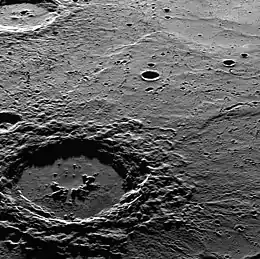Hokusai (crater)
Hokusai is a rayed impact crater on Mercury, which was discovered in 1991 by ground-based radar observations conducted at Goldstone Observatory.[2] The crater was initially known as feature B. Its appearance was so dissimilar to other impact craters that it was once thought to be a shield volcano. However improved radar images by the Arecibo Observatory obtained later in 2000–2005 clearly showed that feature B is an impact crater with an extensive ray system. The bright appearance of rays in the radio images indicates that the crater is geologically young; fresh impact ejecta has a rough surface, which leads to strong scattering of radio waves.[2]
 Photo of Hokusai crater by MESSENGER | |
| Planet | Mercury |
|---|---|
| Coordinates | 58.3°N 342.3°W |
| Quadrangle | Hokusai quadrangle |
| Diameter | 95 km |
| Eponym | Katsushika Hokusai[1] |
Hokusai is named after Katsushika Hokusai (1760–1849), a Japanese artist and printmaker of the Edo period.[3][1] The name Hokusai was suggested by radar astronomer John K. Harmon.[4] The crater has a diameter of about 100 km; the rays extend for thousands kilometers, covering much of the northern hemisphere.[5]
Hokusai is the fourth-largest crater of the Kuiperian system on Mercury. The largest is Bartók crater.[6]
 The rays of Hokusai crater (near central horizon) extend across much of the planet
The rays of Hokusai crater (near central horizon) extend across much of the planet.jpg.webp) The ray system close to the crater
The ray system close to the crater MESSENGER WAC image
MESSENGER WAC image Mosaic of MESSENGER NAC images
Mosaic of MESSENGER NAC images
References
- "Ten Craters On Mercury Receive New Names". SpaceDaily. Retrieved March 29, 2010.
- Harmon, John K.; Slade, Martin A.; Butler, Bryan J.; Head, James W.; Rice, Melissa S.; Campbell, Donald B. (2007). "Mercury: Radar images of the equatorial and midlatitude zones". Icarus. 187 (2): 374–405. Bibcode:2007Icar..187..374H. doi:10.1016/j.icarus.2006.09.026.
- "Hokusai (crater)". Gazetteer of Planetary Nomenclature. USGS Astrogeology Research Program.
- "Hokusai Paints a Wave of Rays". NASA/Johns Hopkins University Applied Physics Laboratory/Carnegie Institution of Washington. 11 May 2010. Archived from the original on 5 October 2013. Retrieved 13 May 2012.
- "PIA11356: Looking Back to the Source". NASA. October 6, 2008. Retrieved March 29, 2010.
- Denevi, B. W., Ernst, C. M., Prockter, L. M., and Robinson, M. S., 2018. The Geologic History of Mercury. In Mercury: The View After MESSENGER edited by Sean C. Solomon, Larry R. Nittler, and Brian J. Anderson. Cambridge Planetary Science. Chapter 6, Table 6.4.
External links
| Wikimedia Commons has media related to Hokusai (crater). |
